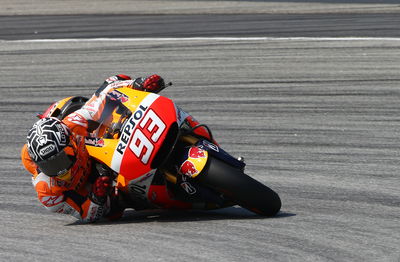Michelin: 'Elbow' style to stay in 2016

MotoGP riders will continue dragging their elbows through corners, despite the change from Bridgestone to Michelin tyres in 2016.
That's the view of Michelin Racing technical director Nicolas Goubert, who says that touching elbows - as well as knees - on the asphalt is a matter of riding style rather than lean angle.
And the source of the current spectacular style is double MotoGP champion Marc Marquez.
"Of course!" smiled Goubert, when asked if the elbow-down style would continue. "For me it's... do you remember Jean-Philippe Ruggia? That guy put his elbow on the ground 15-20 years ago. The fact that the guys are putting their elbow on the ground now is just because Marquez arrived, with a different riding style.
"It's impressive when you watch them, but if you look at the lean angle of the bike... If you measure when Marquez is riding and when Max Biaggi was riding ten years ago, I don't think you'll find a big difference. It's more about rider position.
"But for sure it is nice - and it will continue. No problem!"
 |
| Nicolas Goubert, 2015 Sepang MotoGP test (pic: Gold & Goose) |
Goubert was speaking at Sepang during the final day of last week's MotoGP test, dedicated to Michelin tyre testing and the first chance for race riders to try the prototype 2016 rubber.
The day was overshadowed by four fast accidents, prompting some to question the wisdom of putting riders on completely different tyres straight after three days honing their machines and riding technique for the Bridgestones.
Goubert cited front-rear grip balance as an issue to be addressed and admitted swapping tyre brands at such short notice is difficult for the riders. But the Frenchman also stressed that Michelin hadn't applied any pressure in terms of chasing lap times.
"We didn't try to do a fast lap time and we didn't want the riders to play that game and try to go very fast," he said. "We didn't want anyone to take unnecessary risks. It's difficult for them because in a few weeks they will be back on Bridgestone and then starting the first race. It can give only confusion."
Nevertheless Goubert was "very happy" with the pace at Sepang, especially during a long run by Marquez.
 |
| Marc Marquez tests Michelin tyres at Sepang (pic: Gold & Goose) |
No official lap times were released and riders are unable to speak to the media due to their existing Bridgestone contracts, but the general consensus was a difference of around 1-1.5 seconds to the Bridgestone lap times.
That's pretty impressive given the lack of bike set-up - when comparing different tyres the set-up must stay the same - and early stage of Michelin development. "For the front tyres we only brought one compound and for the rear Marc stayed all the time with the base tyre," Goubert confirmed.
So what exactly did Michelin bring for the race riders to try?
 |
| Valentino Rossi tests Michelin tyres at Sepang (pic: Gold & Goose) |
"We've listened to what we were told by the factory test riders for the last six months," Goubert explained. "After the last test here three weeks ago we picked two different front profiles, in two different construction versions [so four different tyres], and then three rear tyres to bring here. All of the rears were asymmetric, none of the fronts.
"The race riders were quite happy with the rear tyres. When we first tested here with Colin [Edwards] and Aoyama in November, the rears were not that good. The next test at the beginning of February was a lot better and basically we brought that tyre, which we now call the base tyre, today.
"We had different rear compounds that a lot of people didn't even try because they were happy with the base tyre. That is the tyre Marc did the long run with and no problems whatsoever.
"For the front we had two different [shaped] tyre profiles. What Colin had told us was very interesting. He said, 'I much prefer to stay with the smaller profile, but I wouldn't be surprised if Jorge and Vale choose the bigger profile'. And he was right. That's what happened.
"With Honda it was already clear from what Aoyama had said [that the bigger front profile] was the right direction and Marc confirmed it straight away. With Ducati, Pirro said he preferred the smaller profile, but the bigger one had some good points and straight away Dovizioso said the bigger one is better.
"For us it was very important to clarify all that, so we know in which direction to go. Of course, even if all of them picked the bigger front profile they also made some comments and feedback about where they would like to see improvements.
"Overall I think the [GP riders] were happy to see that even among the tyres we brought today there were big differences and that the work we've done with the test riders has paid off. Even if there is a long way to go. That is encouraging for them."
 |
| Colin Edwards during Michelin tyre test at Sepang (pic: Gold & Goose) |
Michelin claimed its first premier-class motorcycle grand prix victory with Jack Findlay in 1973 and had taken 360 wins and 26 riders' titles by the time it left MotoGP at the end of 2008.
But that was during open tyre competition and being a single tyre supplier presents a different challenge.
"The game is different when you are alone rather than fighting somebody," Goubert said. "Now the challenge is to have tyres that are adaptable enough to be used at many different tracks.
"It was a clear request from the teams, who said they were happy with the way they function with Bridgestone. Not changing tyres for every race. Of course when you go somewhere very peculiar like Philip Island, you have to. But when you are racing in Europe and can cover races with the same tyre solutions then it is better.
"That will be the next challenge for the rear. We are more-or-less where we need to be for the profile and construction. Now it is a case of compounds and checking the robustness of the construction. That's why we asked some guys to do long runs."
Michelin is changing the MotoGP wheel size from 16.5 to 17-inch to help with the transfer of technology from track to street. And they will certainly be on track frequently in the build up to 2016.
"We're going to test at most of the MotoGP tracks this season on the Monday after the races with the factory test riders. The teams will split the work up, with probably two teams at each test. Then we'll have three other [test] sessions with the GP riders."
The final tyres will then be chosen for the 2016 season.
 |
| Hiroshi Aoyama (Honda) and Andrea Dovizioso (Ducati) at Sepang Michelin tyre test (pic: Gold & Goose) |
Michelin intend to keep coloured markings on the tyre sideways so that fans and media can see who is using which type of rubber. However Goubert instantly ruled out supplying fast-wearing tyres, which F1 insisted upon to help spice-up the racing action.
"No," he stated. "One of the key elements for the Michelin brand is always the longevity of the product. So every time we do any racing we always to try to have the best compromise possible between grip and longevity.
"Here [in MotoGP] we'll do everything we can to have the fastest lap on the last lap of the race. I mean to have no degradation. And basically what Marc did today we are already very close to that. We do not intend to work in a different way.
"Talking about Formula One, that is one of the reasons why we didn't go back to Formula One. We were very interested, but not with the regulations they have and not with what they asked the tyre maker to do.
"Because for us it's exactly the opposite of what we want to show. It would be counterproductive. So no way were we willing to do that."
Michelin's most recent MotoGP title was with Repsol Honda's Nicky Hayden in 2006. Casey Stoner (Ducati) and Valentino Rossi (Yamaha) then won titles with Bridgestone before the single-tyre era began with the Japanese company in 2009.
 |
| Jean-Philippe Ruggia, Catalunya 250GP 1993 (pic: Gold & Goose) |












